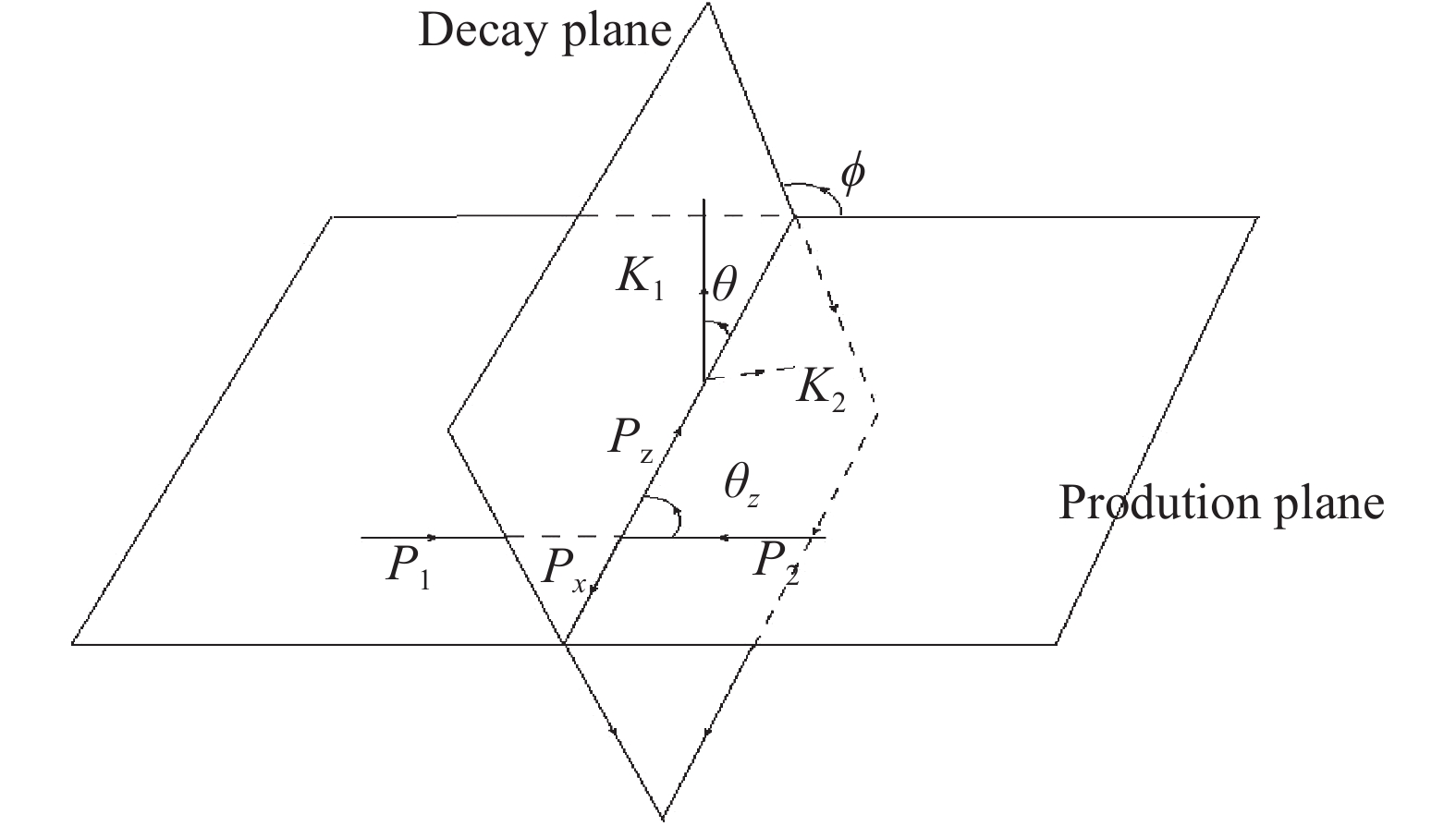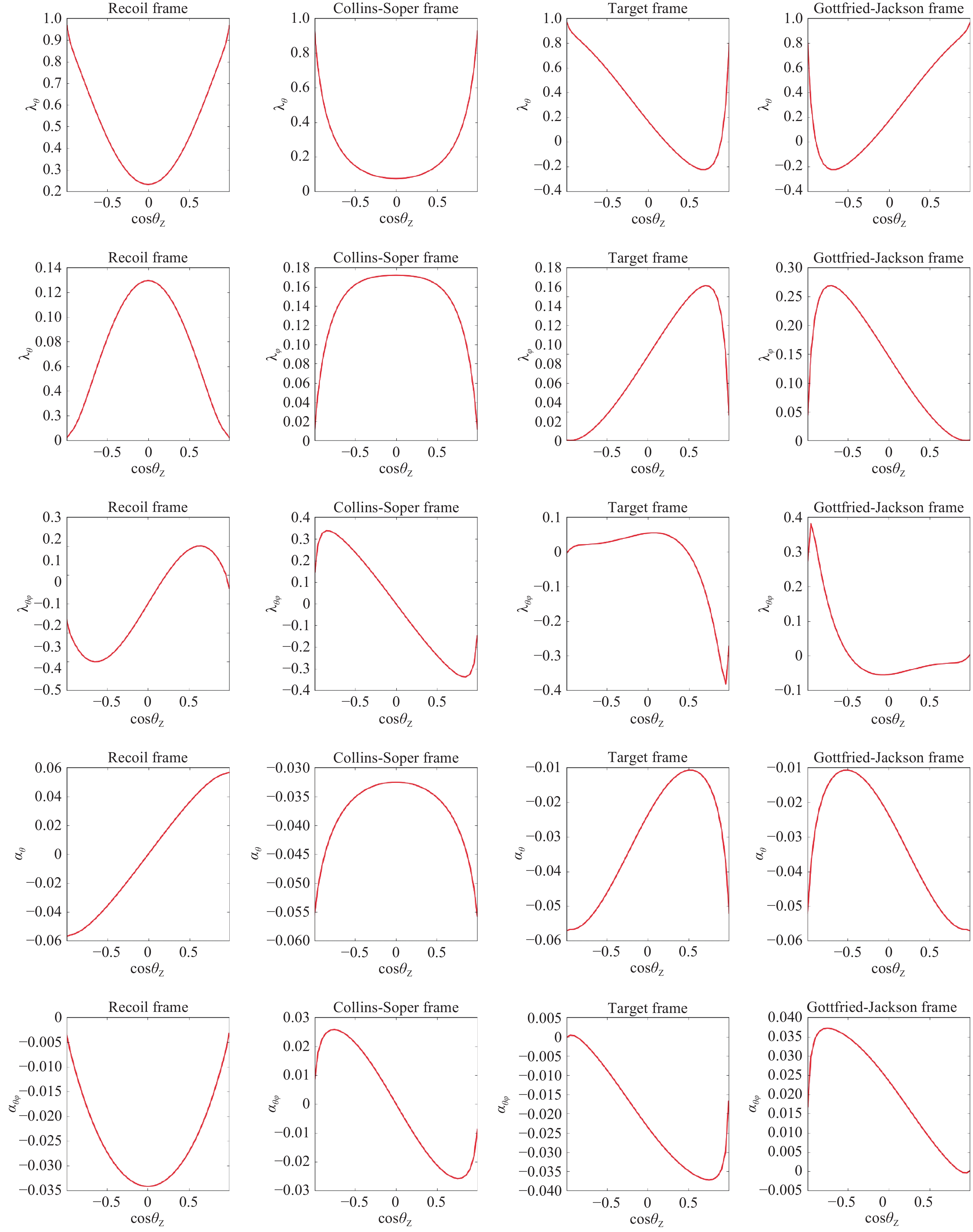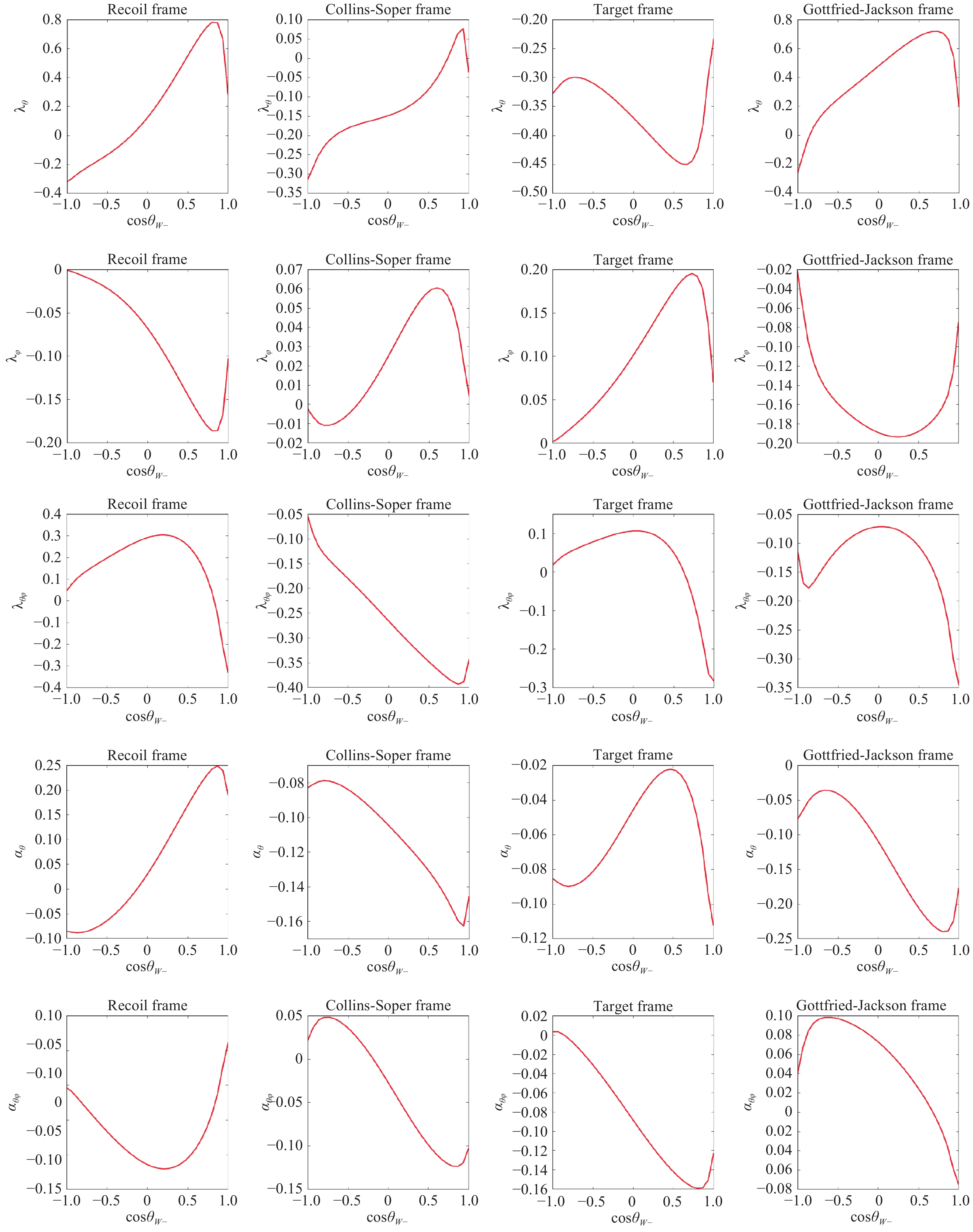HTML
--> --> -->The Drell-Yan type processes provide a powerful method to understand the production mechanism of the gauge boson and to explore the new physics. In 1983, W and Z boson were discovered [8, 9], and some measurements were found to be consistent with the predictions of the V-A Standard Model [10-12]. The measurement of the angular distribution coefficients of the lepton pair in Z/
The circular electron-positron collider (CEPC) is proposed to be built in the future. It is designed such that the center-of-mass (CM) energy has a maximum energy of 240 GeV and a higher luminosity than the linear collider [21]; this will have less background compared with the hadron collider. The CEPC project aims to precisely test the properties of the Higgs, Z, and W boson, and investigate new physics. Compared with the process at the hadron collider, a similar process,
In this study, we investigate the angular distribution coefficients of Z boson inclusive production. In comparison with the Z boson hadroproduction, the energy of a Z boson is fixed at leading-order (LO) at
The angular differential cross section can be written as
$\frac{{\rm d}\sigma}{{\rm d}\cos\theta_Z {\rm d}\Omega}=\sum_{\lambda \lambda^\prime}\frac{{\rm d}\sigma_{\lambda \lambda^\prime}}{{\rm d}\cos\theta_Z}f_{\lambda \lambda^\prime}(\theta, \varphi),$ | (1) |
The remainder of this paper is organized as follows. In Section 2, we present the general expression of the lepton angular distribution of this process. We also represent the angular coefficients by the gauge boson production density matrix elements. In Section 3, we numerically calculate the angular distribution coefficients for the total and differential cross section in different polarization frames. In Section 4, we present the figures of the angular coefficients of Z(W) production dependence on cos
 Figure1. Production and decay planes and various angles in lab frame.
Figure1. Production and decay planes and various angles in lab frame.The dilepton angular distribution is defined in the Z boson rest frame, and we use this frame in the following discussion. The invariant mass window of Z boson is chosen at approximately 91.19 GeV. The total cross section can be represented as
$\begin{split}\sigma & = (M_{\gamma^*}+M_z)(M_{\gamma^*}+M_z)^*\\ & = |M_{\gamma^*}|^2+|M_z|^2+2{\rm Re}(M_{\gamma^*}M_z^*)\\ & = \sigma_{\gamma^*}+\sigma_z+\sigma_{\gamma^* z}, \end{split}$ | (2) |
To obtain a more precision estimation, the cross section for
The momentum of Z boson,
$\begin{split}& p_Z =(E, 0, 0, 0), \\ & k_1 =\frac{E}{2}(1, \sin \theta \cos\varphi, \sin\theta \sin\varphi, \cos\theta), \\ & k_2 =\frac{E}{2}(1, -\sin\theta \cos\varphi, -\sin\theta \sin\varphi, -\cos\theta), \end{split}$ | (3) |
$\epsilon_\pm=\left(0, \mp\frac{1}{\sqrt{2}}, -\frac{i}{\sqrt{2}}, 0\right), \epsilon_0=(0, 0, 0, 1).$ | (4) |
$\begin{split}M_i & = M_{e^+e^-\to ZX_i}^\mu \frac{-i\left(g_{\mu \nu}-\displaystyle\frac{p_{z\mu} p_{z\nu}}{m_z^2+im_z\Gamma }\right) }{p_z^2-m_z^2-im_z\Gamma_z}M_{Z\to l^+l^-}^\nu \\ & = \sum_\lambda M_{e^+e^-\to ZX_i}^\mu \frac{\epsilon_{\lambda\mu} \epsilon^*_{\lambda\nu}}{m_z\Gamma_z} M_{Z\to l^+l^-}^\nu = \sum_\lambda a_{\lambda}(X_i)\frac{1}{m_z \Gamma_z}b_\lambda, \end{split}$ | (5) |
$\begin{split}& \sigma_{\lambda \lambda^{\prime}}= \sum_ia_\lambda (X_i) a_{\lambda^\prime}^*(X_i), \\ & D_{\lambda \lambda^{\prime}} = \sum_{s_1, s_2}b_\lambda b_{\lambda^\prime}^*, \\ & b_\lambda = \bar{\mu}(k_2, s_2)(ig_v \gamma_\mu+ig_a \gamma_\mu \gamma_5)\nu(k_1, s_1) \epsilon_\lambda^*, \end{split}$ | (6) |
By applying
$\begin{split}\frac{{\rm d}\sigma}{{\rm d}\Omega}& \propto (g_v^2+g_a^2)Sp^2(1+\lambda_{\theta}\cos^2\theta \\ + &\lambda_{\varphi}\sin^2\theta \cos(2\varphi)+\lambda_{\theta \varphi}\sin(2\theta) \cos\varphi \\ + &\lambda_{\varphi}^\bot \sin^2\theta \sin(2\varphi)+\lambda_{\theta \varphi}^\bot \sin(2\theta) \sin\varphi \\ + &\alpha_{\theta} \cos\theta+\alpha_{\theta \varphi} \sin\theta \cos\varphi +\alpha_{\theta \varphi}^{ \bot } \sin\theta \sin\varphi), \end{split}$ | (7) |
$\begin{split}& S = {\sigma _{ + + }} + {\sigma _{ - - }} + 2{\sigma _{00}}, \\ & {\lambda _\theta } = \frac{{{\sigma _{ + + }} + {\sigma _{ - - }} - 2{\sigma _{00}}}}{S}, \;\;\;\;\;\;\;\;\;\;{\lambda _\varphi } = \frac{{2{\rm Re}({\sigma _{ - + }})}}{S}, \\ & \lambda _\varphi ^ \bot = \frac{{ - 2{\rm Im}({\sigma _{ - + }})}}{S}, \;\;\;\;\;\;\;\;\;\;\;\;\;\;\;\;\;\;\;\;{\lambda _{\theta \varphi }} = \frac{{\sqrt 2 {\rm Re}({\sigma _{ + 0}} - {\sigma _{ - 0}})}}{S}, \\ & \lambda _{\theta \varphi }^ \bot = \frac{{\sqrt 2 {\rm Im}({\sigma _{ + 0}} + {\sigma _{ - 0}})}}{S}, \;\;\;\;\;\;\;\;{\alpha _\theta } = \frac{{ - 2{A_l}({\sigma _{ + + }} - {\sigma _{ - - }})}}{S}, \\ & {\alpha _{\theta \varphi }} = \frac{{2\sqrt 2 {A_l}{\rm Re}({\sigma _{ + 0}} + {\sigma _{ - 0}})}}{S}, \;\;\alpha _{\theta \varphi }^ \bot = \frac{{2\sqrt 2 {A_l}{\rm Im}({\sigma _{ + 0}} - {\sigma _{ - 0}})}}{S}.\end{split}$ | (8) |
As presented in Appendix A, there are relations Eq. (A5) for the real part in
$\begin{split} & - 1 \leqslant {\lambda _\theta } \leqslant 1, \;\;\;\;\;\;\;\;\;\;\;\;\;\;\;\;\;\;\;\;\, - 1 \leqslant {\lambda _\varphi } \leqslant 1, \\ & \frac{{ - 1}}{{\sqrt 2 }} \leqslant {\lambda _{\theta \varphi }} \leqslant \frac{1}{{\sqrt 2 }}, \;\;\;\;\;\;\;\;\;\;\;\;\; - 2{A_l} \le {\alpha _\theta } \leqslant 2{A_l}, \\ & - \sqrt 2 {A_l} \leqslant {\alpha _{\theta \varphi }} \leqslant \sqrt 2 {A_l}, \;\;\; - 1 \leqslant \lambda _\varphi ^ \bot \leqslant 1, \\ & \frac{{ - 1}}{{\sqrt 2 }} \leqslant \lambda _{\theta \varphi }^ \bot \leqslant \frac{1}{{\sqrt 2 }}, \;\;\;\;\;\;\;\;\;\;\;\;\;\; - \sqrt 2 {A_l} \leqslant \alpha _{\theta \varphi }^ \bot \leqslant \sqrt 2 {A_l}, \end{split}$ | (9) |
$\begin{split}& e^+ +e^- \to Z + \gamma \to l^+ +l^- + \gamma, \\ & e^+ +e^- \to Z + Z \to l^+ +l^- + Z, \\ & e^+ +e^- \to Z + H \to l^+ +l^- + H.\end{split}$ | (10) |
In these three processes, the
cos  |   |   |   |   |   |   |   |   | Total cross section(pb) |
cos  | 0.937 | 0.008 | 0.030 | 0.031 | ?0.0003 | 0 | 0 | 0 | 23.90 |
cos  | 0.937 | 0.008 | ?0.030 | ?0.031 | ?0.003 | 0 | 0 | 0 | 23.90 |
| total | 0.937 | 0.008 | 0 | 0 | ?0.003 | 0 | 0 | 0 | 47.80 |
Table1.Values of angular distribution coefficients and total cross section for Z boson productions at
 Figure2. (color online) Differential cross section of Z(W) boson production.
Figure2. (color online) Differential cross section of Z(W) boson production.The cross section is much smaller compared with the Drell-Yan type process in hadron collisions [27] at LO; to obtain accurate measurements, larger integrated luminosity is required. From the CEPC design report [21], at the CM energy
The value of
From Table 1, the values of
The process
cos  |   |   |   |   |   |   |   |   | Total cross section (pb) |
cos  | 0.532 | ?0.237 | ?0.072 | 1.333 | ?0.042 | 0 | 0 | 0 | 96.61 |
cos  | 0.095 | ?0.1467 | 0.144 | ?0.354 | ?0.574 | 0 | 0 | 0 | 9.95 |
| total | 0.486 | ?0.227 | ?0.048 | 1.156 | ?0.099 | 0 | 0 | 0 | 106.64 |
Table2.Values of angular distribution coefficients and total cross section for
$\begin{split} p_{\bar{\nu}}^2=(p_1+p_2-p_{X}-p_{e^-})^2=0, \\ (p_{\bar{\nu}}+p_{e^-})^2=(p_1+p_2-p_{X})^2=m_W^2\end{split}$ | (11) |
cos  | 0-0.45 | 0.45-0.7 | 0.7-0.9 | 0.9-0.94 | 0.94-0.99 | 0.99-1.00 |
  | 0.83 | 0.71 | 1.20 | 0.54 | 1.80 | 20.00 |
| N (1 year) | 6.6×105 | 5.7×105 | 9.6×105 | 4.3×105 | 1.44×106 | 1.60×107 |
| N (7 year) | 4.7×106 | 4.0×106 | 6.7×106 | 3.0×106 | 1.01×107 | 1.12×108 |
Table3.Cross sections for inclusive Z boson production at different bins of cos
For the detector at the CEPC, the conical space with an opening angle is approximately 6.78-8.11 degrees, which correspond to the values of cos
In Fig. 3, we show the dependence of the angular coefficients on cos
 Figure3. (color online) Angular distribution coefficients of the inclusive Z boson production dependence on cosθZ.
Figure3. (color online) Angular distribution coefficients of the inclusive Z boson production dependence on cosθZ. Figure4. (color online) Angular distribution coefficients of the inclusive W? boson production dependence on cosθW.
Figure4. (color online) Angular distribution coefficients of the inclusive W? boson production dependence on cosθW.Then, in Fig. 4, the same plots for
cos  |   |   |   |   |   |
| ?1.0?0.99 | 0.996 | 0 | 0.015 | ?0.028 | 0 |
| ?0.99?0.94 | 0.843 | 0.017 | 0.196 | ?0.054 | 0.012 |
| ?0.94?0.9 | 0.723 | 0.024 | 0.228 | ?0.050 | 0.015 |
| ?0.9?0.7 | 0.480 | 0.086 | 0.291 | ?0.045 | 0.022 |
| ?0.7?0.45 | 0.335 | 0.110 | 0.223 | ?0.040 | 0.019 |
| ?0.45 ? 0 | 0.216 | 0.135 | 0.100 | ?0.036 | 0.009 |
| 0?0.45 | 0.216 | 0.135 | ?0.100 | ?0.036 | ?0.009 |
| 0.45?0.7 | 0.335 | 0.110 | ?0.223 | ?0.040 | ?0.019 |
| 0.7?0.9 | 0.480 | 0.086 | ?0.291 | ?0.045 | ?0.022 |
| 0.9?0.94 | 0.723 | 0.024 | ?0.228 | ?0.050 | ?0.015 |
| 0.94?0.99 | 0.843 | 0.017 | 0.196 | ?0.054 | 0.012 |
| 0.99?1.0 | 0.996 | 0 | 0.015 | ?0.028 | 0 |
Table4.Angular distribution coefficients for Z boson production at each bin in cos
cos  |   |   |   |   |   |
| 0?0.454 | 0.328 | ?0.105 | 0.295 | 0.652 | ?0.776 |
| 0.454?0.707 | 0.635 | ?0.160 | 0.209 | 1.288 | ?0.597 |
| 0.707?0.891 | 0.772 | ?0.185 | 0.019 | 1.598 | ?0.226 |
| 0.891?0.987 | 0.688 | ?0.171 | ?0.180 | 1.592 | 0.136 |
| 0.987?1 | 0.250 | ?0.098 | ?0.290 | 1.206 | 0.356 |
Table5.Angular distribution coefficients for
From the numerical results, it is clear that the event number estimated has the lepton pair estimated at the CEPC has the same order of magnitude as that of the ATLAS. The better accurate measurements are expected because there is less background. In comparison with the case at the hadron collider, the measurement for W is of a advantage because the momentum of the missing antineutrino from
Further studies should be conducted that include Monte Carlo simulation with detector and background, the NLO electroweak correction for the production and Z(W) boson decay, NLO QCD correction to Z(W) boson decay, the correction to narrow width approximation, and initial-state-radiation effect. The NLO QCD correction to the angular distribution coefficients are less than 10% for the sum of all contributions in hadron collsions [4, 29]. In comparison with the hadron collision case, there is no NLO QCD correction at
We thank Dr. Bin Gong for the discussions.
2
A.Appendix A: The relations of the density matrix elements
The production density matrix of the vector boson is written as$\tag{A1}\sigma_{\lambda \lambda^\prime}= (M_\mu \epsilon^\mu_\lambda)(M_\nu \epsilon^\nu_\lambda)^\ast, $ |
$\tag{A2}\epsilon_0= \epsilon_z, \epsilon_\pm= \displaystyle\frac{1}{\sqrt{2}}(\mp\epsilon_x-i\epsilon_y), $ |
$\tag{A3}\begin{split}& \sigma_{+ +}= (M_\mu \epsilon^\mu_+)(-M_\nu^\ast \epsilon^\nu_-) = \frac{1}{2}[(M_{1\mu}M_{1\nu}+M_{2\mu}M_{2\nu})(\epsilon_x^\mu\epsilon_x^\nu+ \epsilon_y^\mu\epsilon_y^\nu) -(M_{2\mu}M_{1\nu}-M_{1\mu}M_{2\nu})(\epsilon_y^\mu\epsilon_x^\nu-\epsilon_x^\mu\epsilon_y^\nu)], \\& \sigma_{- -}= (M_\mu \epsilon^\mu_+)(-M_\nu^\ast \epsilon^\nu_-) = \frac{1}{2}[(M_{1\mu}M_{1\nu} +M_{2\mu}M_{2\nu})(\epsilon_x^\mu\epsilon_x^\nu+\epsilon_y^\mu\epsilon_y^\nu) + (M_{2\mu}M_{1\nu}-M_{1\mu}M_{2\nu})(\epsilon_y^\mu\epsilon_x^\nu-\epsilon_x^\mu\epsilon_y^\nu)], \\& \sigma_{+ -}= (M_\mu \epsilon^\mu_+)(-M_\nu^\ast \epsilon^\nu_+) = -\frac{1}{2}(M_{1\mu}M_{1\nu}+M_{2\mu}M_{2\nu})[(\epsilon_x^\mu\epsilon_x^\nu-\epsilon_y^\mu\epsilon_y^\nu)+i(\epsilon_x^\mu\epsilon_y^\nu+\epsilon_y^\mu\epsilon_x^\nu)], \\ & \sigma_{- +}= (M_\mu \epsilon^\mu_-)(-M_\nu^\ast \epsilon^\nu_-) = -\frac{1}{2}(M_{1\mu}M_{1\nu}+M_{2\mu}M_{2\nu})[(\epsilon_x^\mu\epsilon_x^\nu-\epsilon_y^\mu\epsilon_y^\nu)-i(\epsilon_x^\mu\epsilon_y^\nu+\epsilon_y^\mu\epsilon_x^\nu)], \\& \sigma_{0 +}= (M_\mu \epsilon^\mu_0)(-M_\nu^\ast \epsilon^\nu_-) = -\frac{1}{\sqrt{2}}\epsilon_z^\mu\{[(M_{1\mu}M_{1\nu}+M_{2\mu}M_{2\nu})\epsilon_x^\nu+ (M_{2\mu}M_{1\nu}-M_{1\mu}M_{2\nu})\epsilon_y^\nu] \\ & \qquad~ -i[(M_{1\mu}M_{1\nu}+M_{2\mu}M_{2\nu})\epsilon_y^\nu-(M_{2\mu}M_{1\nu}-M_{1\mu}M_{2\nu}) \epsilon_x^\nu]\}, \\& \sigma_{+ 0}= (M_\mu \epsilon^\mu_+)(M_\nu^\ast \epsilon^\nu_0) = -\frac{1}{\sqrt{2}}\epsilon_z^\mu\{[(M_{1\mu}M_{1\nu}+M_{2\mu}M_{2\nu})\epsilon_x^\nu+ (M_{2\mu}M_{1\nu}-M_{1\mu}M_{2\nu})\epsilon_y^\nu] \\ & \qquad~ + i[(M_{1\mu}M_{1\nu}+M_{2\mu}M_{2\nu})\epsilon_y^\nu-(M_{2\mu}M_{1\nu}-M_{1\mu}M_{2\nu}) \epsilon_x^\nu]\}, \\& \sigma_{0 -}= (M_\mu \epsilon^\mu_0)(-M_\nu^\ast \epsilon^\nu_+) = \frac{1}{\sqrt{2}}\epsilon_z^\mu\{[(M_{1\mu}M_{1\nu}+M_{2\mu}M_{2\nu})\epsilon_x^\nu-(M_{2\mu}M_{1\nu}-M_{1\mu}M_{2\nu})\epsilon_y^\nu] \\ & \qquad~ + i[(M_{1\mu}M_{1\nu}+M_{2\mu}M_{2\nu})\epsilon_y^\nu+(M_{2\mu}M_{1\nu}-M_{1\mu}M_{2\nu}) \epsilon_x^\nu]\}, \\ & \sigma_{- 0}= (M_\mu \epsilon^\mu_-)(M_\nu^\ast \epsilon^\nu_0) = \frac{1}{\sqrt{2}}\epsilon_z^\mu\{[(M_{1\mu}M_{1\nu}+M_{2\mu}M_{2\nu})\epsilon_x^\nu-(M_{2\mu}M_{1\nu}-M_{1\mu}M_{2\nu})\epsilon_y^\nu] \\ & \qquad~ - i[(M_{1\mu}M_{1\nu}+M_{2\mu}M_{2\nu})\epsilon_y^\nu+(M_{2\mu}M_{1\nu}-M_{1\mu}M_{2\nu}) \epsilon_x^\nu]\} .\end{split}$ |
$\tag{A4}\begin{split}\sigma_{+ -}=& (\sigma_{- +})^\ast, \\\sigma_{+0}=& (\sigma_{0+})^\ast, \\\sigma_{-0}=& (\sigma_{0 -})^\ast,\end{split}$ |
$\tag{A5}\begin{split}\sigma_{+ +}=& \sigma_{- -}, \\\sigma_{+ -}=& (\sigma_{- +})^\ast, \\\sigma_{+0}=& (\sigma_{0+})^\ast=-\sigma_{0-}=-(\sigma_{-0})^\ast, \end{split}$ |



